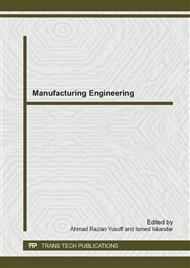p.96
p.102
p.108
p.114
p.118
p.123
p.129
p.135
p.139
Thermal Performance of Polyamide 6/Cloisite 20A Composite Hybrid by Adiabatic Extrusion: A Study on the Influence of Difference Approach of Compounding
Abstract:
In this paper, the possibility of thermal stability enhancement for PA6/Cloisite 20A through the application of adiabatic extrusion was inspected. Samples at 1 wt. %, 3 wt. % and 5 wt. % of clay loading Cloisite 20A were prepared by using adiabatic and conventional compounding with consistent screw speed of 200 RPM. The thermal properties of PA6/C20A nanocomposite were characterized from thermal gravimetric analysis. It has been found that adiabatic extrusion managed to increase the resistant of PA6 against heat degradation for PA6-1wt. % as PA6-3wt. % and PA6-5wt. % did not shown any distinctive in value of Tmin. as adiabatic extrusion does only have a minor effect on the increased content of clay C20A in PA6 based on thermal gravimetric characterization. The combination effect of adiabatic system and clay C20A presence is proposed as the main influence in the enhancement mechanism of thermal characteristic of PA6/C20A nanocomposite.
Info:
Periodical:
Pages:
118-122
Citation:
Online since:
February 2014
Authors:
Keywords:
Price:
Сopyright:
© 2014 Trans Tech Publications Ltd. All Rights Reserved
Share:
Citation:


